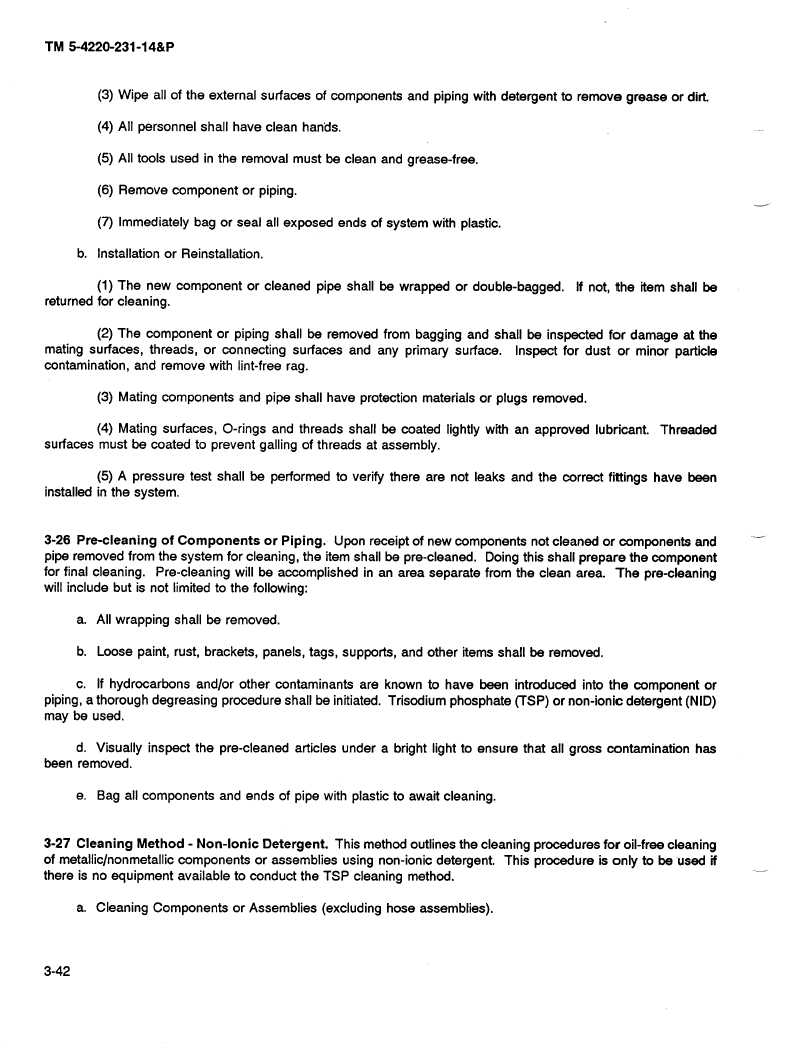TM 5-4220-231-14&P
(3) Wipe all of the external surfaces
of components
and piping with detergent
to remove grease
or dirt
(4) All personnel
shall
have
clean
hands.
(5) All tools
used
in the
removal
must
be clean
and
grease-free.
(6) Remove
component
or piping.
(7) Immediately
bag or seal
all exposed
ends
of system
with plastic.
b.
Installation
or Reinstallation.
(1) The
new
component
or cleaned
pipe shall
be wrapped
or double-bagged.
If not, the
item shall
be
returned
for cleaning.
(2) The
component
or piping
shall
be removed
from bagging
and
shall
be inspected
for damage
at the
mating
surfaces,
threads,
or connecting
surfaces
and
any
primary
surface.
Inspect
for dust
or minor
particle
contamination,
and
remove
with lint-free
rag.
(3) Mating components
and
pipe shall
have
protection
materials
or plugs
removed.
(4) Mating
surfaces,
O-rings
and
threads
shall
be coated
lightly with an approved
lubricant.
Threaded
surfaces
must
be coated
to prevent
galling
of threads
at assembly.
(5) A pressure
test
shall
be performed
to verify there
are
not leaks
and
the
correct
fittings
have
been
installed
in the system.
3-26 Pre-cleaning
of Components
or Piping.
Upon receipt
of new components
not cleaned
or components
and
pipe removed
from the system
for cleaning,
the item shall
be pre-cleaned.
Doing this shall
prepare
the component
for final cleaning.
Pre-cleaning
will be accomplished
in an area
separate
from the
clean
area.
The
pre-cleaning
will include
but is not limited to the following:
a.
All wrapping
shall
be removed.
b.
Loose
paint,
rust, brackets,
panels,
tags,
supports,
and
other
items
shall
be removed.
c.
If hydrocarbons
and/or
other
contaminants
are
known
to have
been
introduced
into the
component
or
piping, a thorough
degreasing
procedure
shall
be initiated.
Trisodium
phosphate
(TSP)
or non-ionic
detergent
(NID)
may
be used.
d.
Visually
inspect
the
pre-cleaned
articles
under
a bright light to ensure
that
all gross
contamination
has
been
removed.
e.
Bag all components
and
ends
of pipe with plastic
to await
cleaning.
3-27 Cleaning
Method
- Non-Ionic
Detergent.
This method
outlines
the cleaning
procedures
for oil-free
cleaning
of metallic/non
metallic
components
or assemblies
using
non-ionic
detergent.
This
procedure
is only to be -used
if
there
is no equipment
available
to conduct
the TSP
cleaning
method.
a.
Cleaning
Components
or Assemblies
(excluding
hose
assemblies).
3-42

